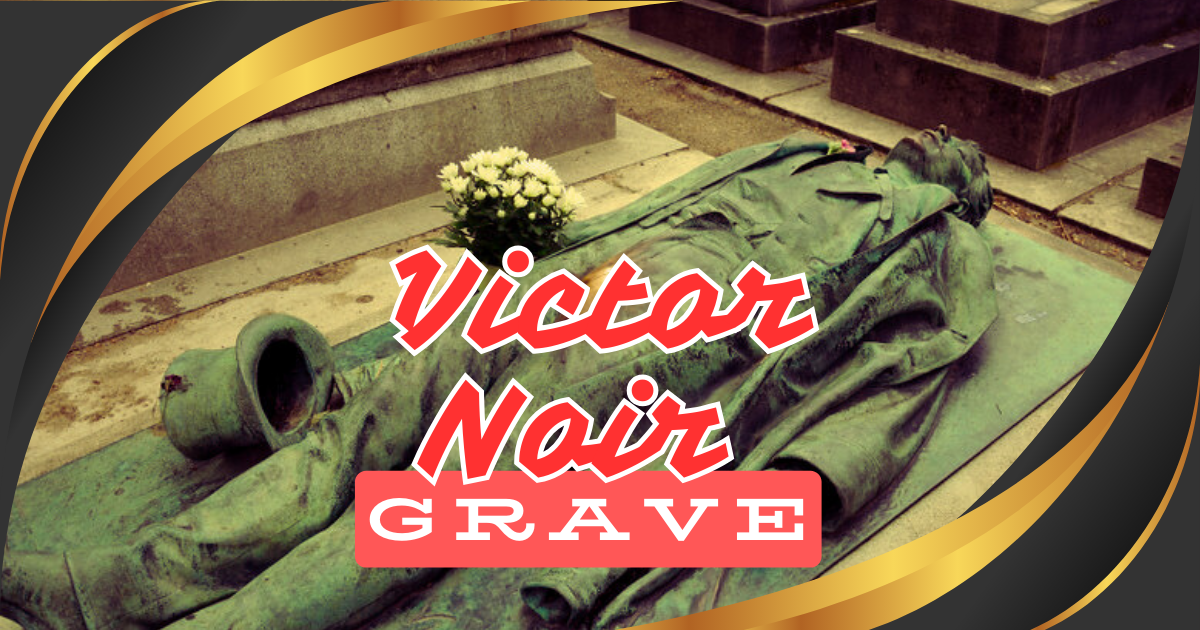The Père Lachaise Cemetery in Paris is known for housing the final resting places of many famous figures, but few graves are as enigmatic and unusual as that of Victor Noir. His tomb, with its bronze statue, has become a peculiar tourist attraction, not just for its striking appearance but also for the mysterious legends surrounding it. In this article, we’ll uncover 5 mysterious facts about the Victor Noir grave and explore why it remains one of the most visited and talked-about graves in Paris.
Who Was Victor Noir? The Life and Legacy of a French Journalist
Before diving into the legend of his grave, it’s essential to understand who Victor Noir was and why his untimely death led to such notoriety. Born Yvan Salmon on July 27, 1848, Victor Noir was a French journalist who wrote for the publication La Marseillaise, a politically charged newspaper. At a time of heightened political tension in France, Noir became embroiled in a conflict that would lead to his tragic and untimely death.
A Deadly Political Encounter
On January 10, 1870, Victor Noir was sent to deliver a message to Prince Pierre Bonaparte, a relative of Emperor Napoleon III. The meeting quickly escalated into violence, and Noir was fatally shot by the Prince. His death sent shockwaves through France, sparking protests and public outrage, as Noir came to be seen as a martyr of the republican cause.
His funeral attracted over 100,000 people, and his grave has since become a symbol of defiance against political tyranny, as well as a curious attraction due to the legends that have emerged around it.
As we delve deeper into history’s impactful figures, explore Abraham Pollack: 5 Incredible Facts You Must Know, shedding light on his influential role in Jewish history.
Why Is Victor Noir Grave So Famous? Uncovering the History
Victor Noir grave at the Père Lachaise Cemetery is famous not only because of his status as a political martyr but also due to the peculiar features and rituals associated with his tomb. After his death, a life-sized bronze statue of Noir was commissioned by French sculptor Jules Dalou, which depicts Noir lying flat on his back, wearing a long coat and boots, with his hat resting beside him. The statue is a realistic portrayal of how he looked at the time of his death, capturing the lifeless body of the young journalist.
While the statue itself is remarkable for its artistic quality, there is one specific feature that has made it a subject of fascination: an exaggerated bulge in Noir’s trousers. Over time, this detail has led to the development of myths and rituals involving the grave, which have attracted visitors from all over the world.
The Legend of Victor Noir’s Tomb: Fertility Rituals and Symbolism
One of the most intriguing aspects of Victor Noir grave is the fertility ritual that has emerged around his statue. According to local legend, women who visit his grave believe that touching certain parts of the statue will increase their fertility or bring good luck in matters of love. Specifically, the shiny, worn-out areas on the nose, lips, and the bulge in his trousers are where visitors most frequently touch, as these spots are believed to enhance a woman’s fertility or improve her chances of finding a lover.
The Rituals and Their Popularity
The rituals associated with Victor Noir grave have evolved into something of a superstition, with women often leaving flowers, kissing the statue’s lips, or placing their hands on the bulge in hopes of receiving its supposed powers. This strange tradition has persisted for decades and continues to attract curious visitors.
The bronze statue’s worn, shiny areas from years of repeated touching are visible signs of the ritual’s lasting popularity. Whether people believe in the fertility legend or are simply fascinated by the unusual history of the tomb, the Victor Noir grave remains one of the most visited and talked-about monuments in Père Lachaise.
A Visit to Père Lachaise: Exploring the Victor Noir Grave
For visitors to Paris, the Père Lachaise Cemetery is a must-see, not only because of its rich history and serene beauty but also because of the many famous gravesites it houses. Among them, the Victor Noir grave is one of the most unusual and visually striking.
How to Find the Grave
The Père Lachaise Cemetery can be overwhelming due to its vast size and the sheer number of famous individuals buried there. Fortunately, the Victor Noir grave is located in Division 92 of the cemetery, and maps are available at the entrance to help visitors navigate the grounds. The tomb’s life-sized statue is instantly recognizable and often surrounded by curious onlookers.
What to Expect During Your Visit
When visiting Victor Noir grave, you’ll likely find it among other notable figures like Oscar Wilde, Jim Morrison, and Édith Piaf, whose graves are also popular attractions. The tranquil atmosphere of Père Lachaise adds to the mystique of Noir’s tomb, and the fertility rituals, whether taken seriously or humorously, are part of the quirky experience that makes this visit memorable.
For history enthusiasts, the Victor Noir grave offers a glimpse into a tumultuous political era in French history. For others, it’s a fascinating example of how legends and myths can turn a grave into something more than just a resting place.
The Death of Victor Noir: The Political Conflict Behind the Tragedy
Victor Noir’s death is rooted in the political unrest of France in the late 19th century. At the time, France was divided between Republicans and Bonapartists, with tensions between these factions running high. As a journalist for the republican-leaning newspaper La Marseillaise, Victor Noir became caught up in this conflict.
The Fatal Meeting with Prince Pierre Bonaparte
Noir was sent to deliver a message to Prince Pierre Bonaparte, the cousin of Emperor Napoleon III, to resolve a disagreement that had arisen between the Prince and the newspaper’s editor. However, the meeting took a deadly turn when a heated argument broke out, and Bonaparte shot Noir, killing him instantly.
The public was outraged by Noir’s death, viewing him as a victim of monarchist oppression. His funeral became a massive public demonstration against the ruling empire, with over 100,000 people attending to show their support for the republican cause. This event cemented Noir’s legacy as a symbol of resistance, and his grave became a rallying point for political movements over the years.
Famous Graves in Père Lachaise Cemetery: A Tour of Parisian Legends
While Victor Noir’s grave is one of the most famous at Père Lachaise, it’s by no means the only notable monument in this legendary cemetery. Visitors often come to Père Lachaise to see the final resting places of many other famous individuals.
1. Oscar Wilde’s Tomb
The grave of Oscar Wilde, the Irish playwright and poet, is another major attraction. Known for its large sphinx-like sculpture, Wilde’s grave has been a site of pilgrimage for admirers of his work, and it was once customary for visitors to kiss the grave and leave lipstick marks as a tribute to the author.
2. Jim Morrison’s Grave
The lead singer of The Doors, Jim Morrison, is buried at Père Lachaise, and his grave continues to draw music fans from around the world. Although the grave is relatively modest compared to others in the cemetery, its cultural significance makes it one of the most visited sites.
3. Édith Piaf’s Grave
The legendary French singer Édith Piaf, known for her timeless songs like “La Vie en Rose,” is buried at Père Lachaise. Her grave is often adorned with flowers and mementos from fans paying their respects to the beloved chanteuse.
For those intrigued by history’s unexpected tales, uncover 7 Surprising Facts About a History of Royal Scorchios You Need to Know, revealing the royal connections that weave through history.
What Makes Victor Noir’s Statue Unique? The Iconic Bronze Effigy
The statue of Victor Noir that adorns his grave is not just an ordinary grave marker; it’s a work of art with deep symbolic significance. Created by the renowned sculptor Jules Dalou, the statue is a life-sized representation of Noir, capturing the moment he was fatally shot.
Realistic Details
Dalou’s statue is noted for its remarkable realism. The detailed craftsmanship can be seen in Noir’s coat, boots, and hat, which lie beside him. His posture and facial expression evoke a sense of calm and dignity, despite the tragic nature of his death.
The Controversial Bulge
The most controversial and discussed feature of the statue is the prominent bulge in Noir’s trousers. Over the years, this detail has taken on symbolic meaning, leading to the fertility rituals that have become synonymous with his grave. While this was likely an artistic choice to capture the lifelike appearance of the body, it has since become the focal point of the legends surrounding the tomb.
Conclusion: The Legend and Legacy of Victor Noir Grave
The Victor Noir grave at Père Lachaise Cemetery is much more than a final resting place for a young journalist. It has become a symbol of political resistance, a unique piece of artistic history, and a place of intrigue thanks to the fertility legends and rituals that have grown around it. Whether you’re a history buff, an art enthusiast, or simply curious about the legends that surround it, a visit to the Victor Noir grave offers a fascinating glimpse into Parisian history and culture.
FAQs About Victor Noir Grave
- Who was Victor Noir?
Victor Noir was a French journalist who became a symbol of political resistance after his death in 1870 at the hands of Prince Pierre Bonaparte. - Why is Victor Noir grave famous?
His grave is famous due to the life-sized bronze statue marking his tomb, as well as the fertility rituals and myths surrounding it. - Where is Victor Noir buried?
Victor Noir is buried in Père Lachaise Cemetery in Paris, located in Division 92 of the cemetery. - What are the rituals associated with Victor Noir grave?
Visitors, particularly women, touch specific parts of the statue for fertility and good luck, particularly the bulge in his trousers, lips, and nose. - Who sculpted Victor Noir’s tomb statue?
The statue was sculpted by Jules Dalou, a renowned French artist. - Why did Victor Noir become a martyr?
Noir’s death was politically charged, and his funeral attracted over 100,000 people protesting the ruling empire, making him a symbol of resistance. - Is the fertility legend around Victor Noir grave real?
While the fertility legend is widely believed by some visitors, it is rooted in superstition rather than scientific evidence. - What makes Victor Noir’s statue different from other graves?
The statue’s realistic portrayal of Noir and the controversial bulge have made it a unique and talked-about monument. - Can I visit Victor Noir grave today?
Yes, visitors can still visit Victor Noir’s grave at Père Lachaise Cemetery, which remains one of the most visited graves in Paris. - What other famous graves are near Victor Noir tomb?
Other notable graves include Oscar Wilde, Jim Morrison, and Édith Piaf, all located within Père Lachaise Cemetery

Joseph Bush is a seasoned writer and researcher with over 7 years of experience covering a wide range of general topics, from lifestyle and technology to business and current events. He is dedicated to producing fact-checked, reader-friendly content that informs, engages, and empowers readers.
Throughout his career, Joseph has followed strict editorial guidelines, relied on reputable sources, and ensured every article meets the highest standards of accuracy and clarity. His expertise spans multiple fields, allowing him to explain complex topics in a way that’s easy to understand.
Passionate about continuous learning, Joseph stays updated on industry trends and best practices to deliver trustworthy, well-rounded insights. Readers can rely on his work for its credibility, depth, and real-world relevance.




